Impressionism
1/58
There's no tags or description
Looks like no tags are added yet.
Name | Mastery | Learn | Test | Matching | Spaced |
|---|
No study sessions yet.
59 Terms
Independent art exhibitions
1863 - Napoleon established the Salon des Refuses to exibit works rejected by the official Salon
1867 - Manet held a private exhibition
1874 - Anonymous Society of Painters, Sculptors and Printmakers held their first exhibition
Anonymous Society of Painters, Sculptors and Printmakers
Founding members: Monet, Renoir, Degas, Pissarro, Sisley, Cezanne and Morisot
Monet’s “Impression: Sunrise” was badly criticised by Louis Leroy and the group was ironically named the Impressionists
Group held 8 exhibitions from 1874 to 1886
Impressionism
Anti-academic standard and values.
Influenced by Realism:
liberation of art from traditional themes, painting real people, real life
painting en plein air, finished works outdoor, under sunlight
pursuit of optical realism - captured the fleeting moments of the rapidly changing world, conveying the elusiveness and impermanence of images and conditions
Themes of Impressionism
Themes:
contemporary lifestyles - modern Parisian life and leisure activities, such as horse-racing, water sports, parties and performances
landscape and cityscape
images of the floating world - influence of Japanese art
images of Bohemian artists and their friends
Style of Impressionism
Style:
developed a scientific attitude towards the structure of colour and light - systematic use complementary colours, use of coloured shadows (Eugene Delacroix) - sepia eliminated
juxtaposition of colours very blunt instead of mixing for smooth transitions
broken brush strokes, blurry images and sketch-like finish
influenced by Japanese woodcut prints - unusual format and angle of composition, themes, homogenous colour → flatness and abstraction
influenced by photography - snapshot like compositions, arbitrary poses and figures
Paint tubes
invented by John Rand in 1841
enabled painters to do on-site sketches in oil much more conveniently
wide range of synthetic colours available
Edouard Manet (1832-1883)
born in Paris, rich family
studied with Thomas Couture, a neoclassicist
interested in Delacroix’s theory of colour and Corot’s idea of Realism
attracted by Spanish and Dutch Baroque painting
1865 - travelled to spin, impressed by the works of Francisco de Goya
influenced and was influenced by the main members of the Impressionists but never exhibited with them
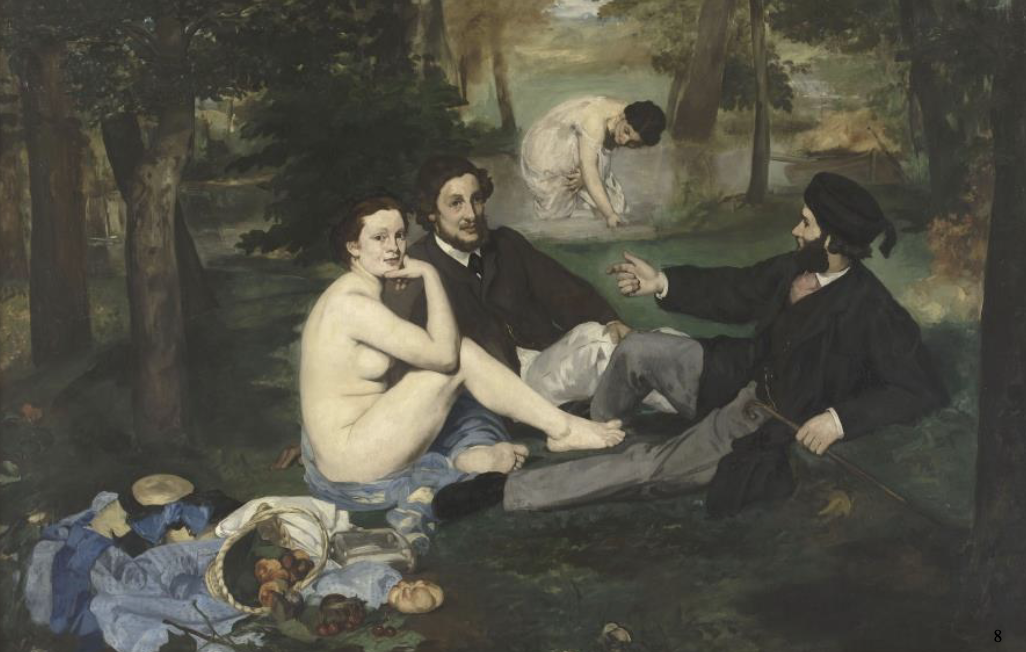
Le Déjeuner sur l’herbe (Luncheon on the grass), Edouard Manet 1863
persons in the foreground are his brother Eugene on the right, sculptor Ferdinand Leenhof in the middle model Victorian Meurend
chief actor in the painting is light - objects are treated as flat planes reacting to light perceived by the eyes
exhibited in the Salon des Refusés, shocking subject matter and style
critique: ordinary men and promiscuous women in a Parisian park
adopted the classical triangular composition and posture of figure from a Renaissance sketch copied from Raphael
Also inspired by Titian - man and nature in harmony with idyllic setting and idealised figures
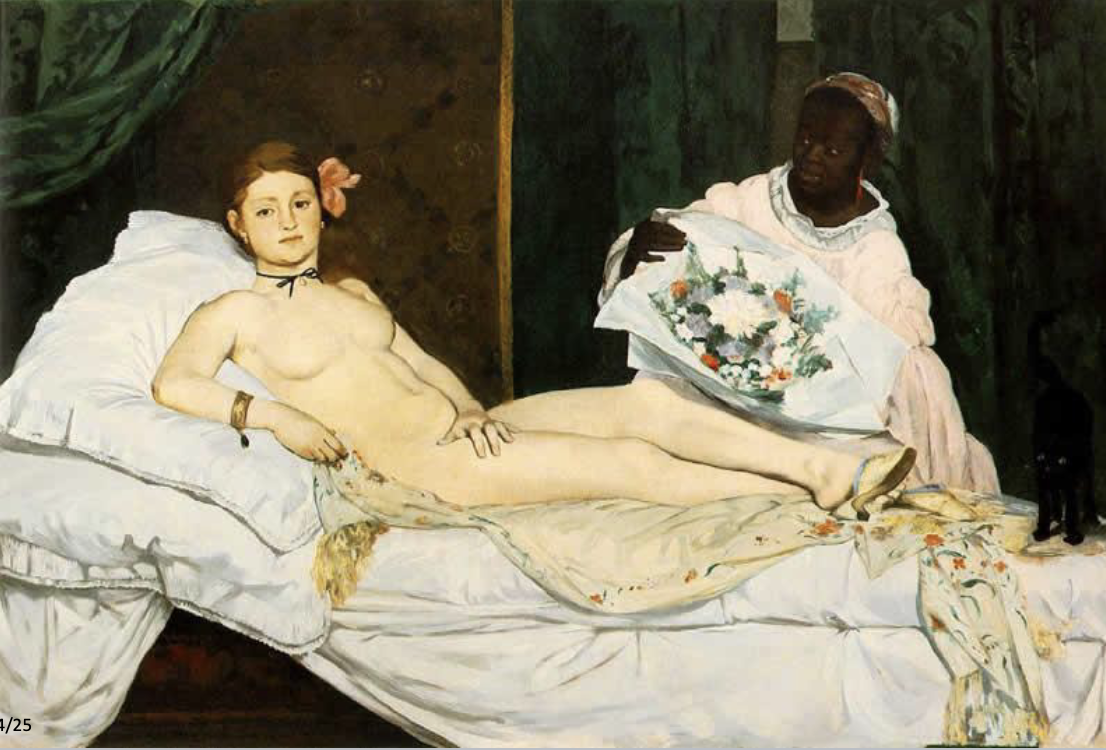
Olympia, Edouard Manet 1863
scandalous - a prostitute with a confrontational gaze in a shameless, provocative pose
criticised for the rough brushstrokes, composition in pure colours, no intermediate tones to fuse the different colours together
echoes Titian’s Venus of Urbino, direct dialogue with the viewer through eyesight, exposing sexual appeal without shame → eroticism
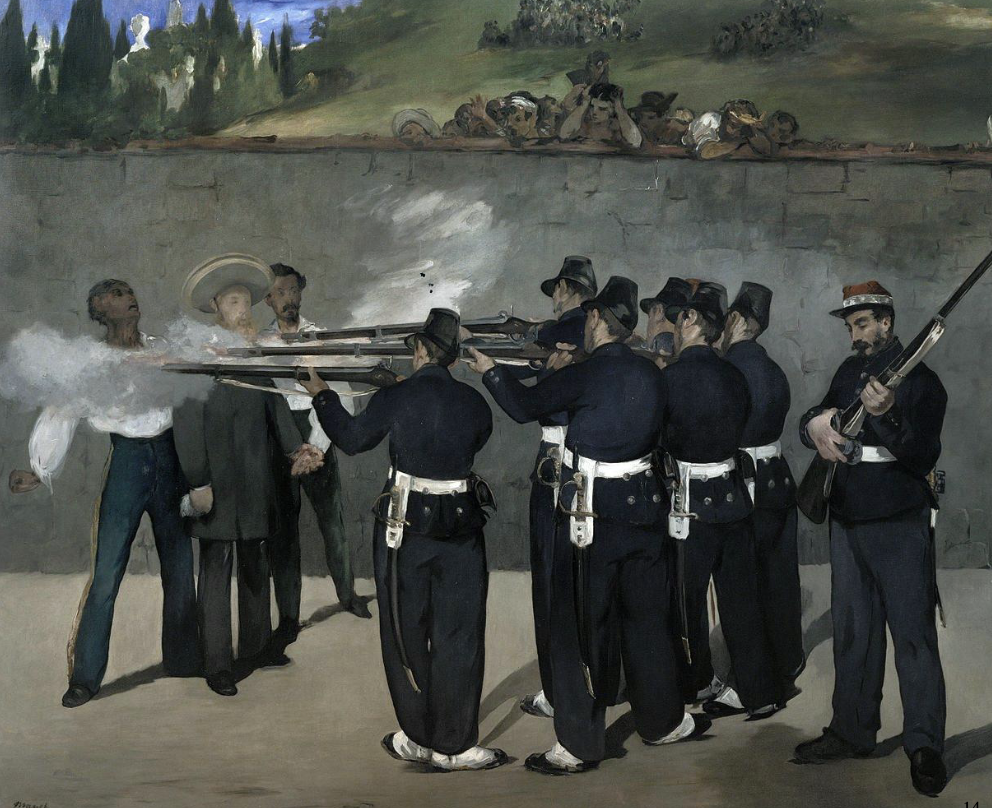
Execution of Emperor Maximilian, Edouard Manet 1868-69
critique of Napoleon III’s politics in Mexico
echoes the works of De Goya, who Manet was impressed with, specifically the execution of rioters in Paris without fair trial
Flatness of the uniformed figures and sketchy finish of the background
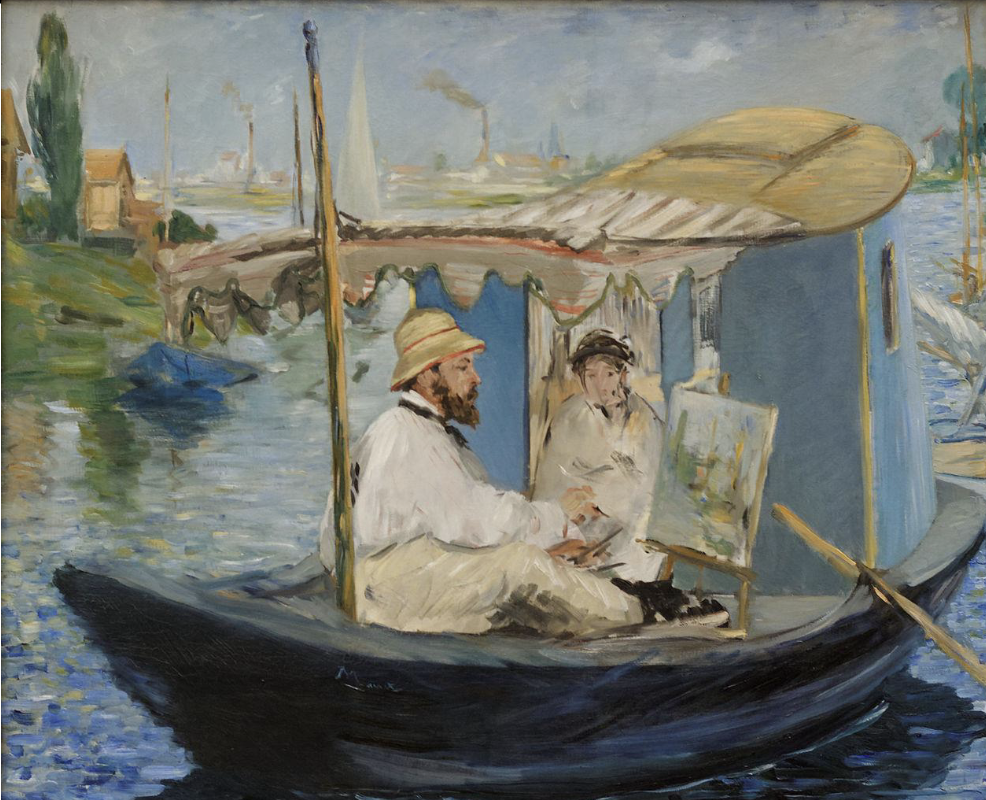
Monet working on his boat in Argenteuil, Edouard Manet 1874
influenced by Monet and is friends - painted together en plein air
Manet came from a rich family so he was never a close friend of the Bohemian artists, however he was introduced to Monet through Berthe Morisot and became a friend of Monet
Claude Oscar Monet (1840-1926)
Born in Paris but moved to Le Havre in Normandy in 1845 and worked as a caricaturist in his teenage years
1850s & 1860s - influenced by Pre-Impressionists such as Eugene Boudin, a local landscape painter, Johann Bartholdi Jongkind, a Dutch landscape painter. Idea of catching the ever-chaning color and light to represent the vivid and vital energy of objects
1859 - entered the studio of Marc Gabriel Gleyre, a neoclassicist, in Paris
1868 - moved to Bougival, became neighbours with Auguste Renoir
1870-71 - stayed in London due to the Franco-Prussian War
1871-78 - moved to Argenteuil, lived partially in his boat studio
1883 - settled in Giverny
renewed landscape painter

Women in the Garden, Claude Monet 1866
Painted totally outdoor to capture the bright sunlight on the dresses, the ground, the trees and other objects

La Grenouillere, Claude Monet 1869
western suburb of Paris, a meeting place for sportsmen and strollers along the river Seine in Bougival
developed the characteristic coarse, broken brushstrokes of Impressionism - allow for the human eye to do the color mixing
Technique: thick, flat colour patches like white, blue, ochre and brown are juxtaposed to capture the movement of the water surface
Theme: sunlight and water movement
Purpose: capture the fleeting and floating light effect of objects
Often painted with Renoir, who focused more eon human figures and activities - enclosed composition with focus on the human group in the centre
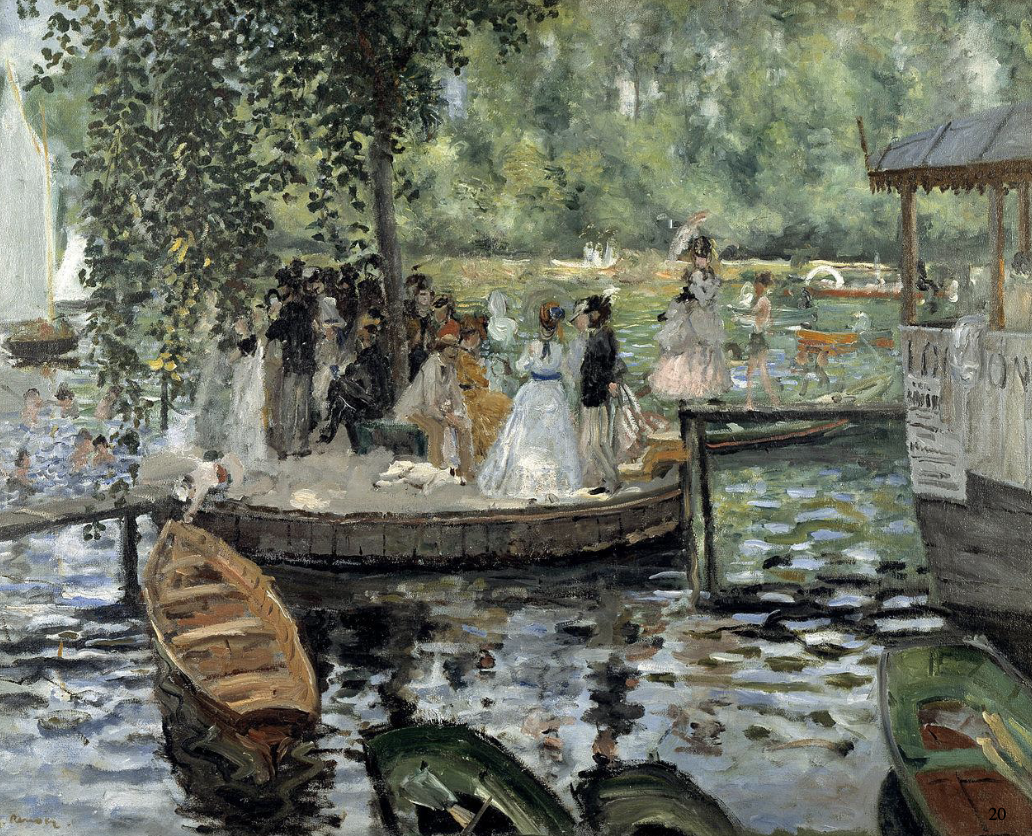
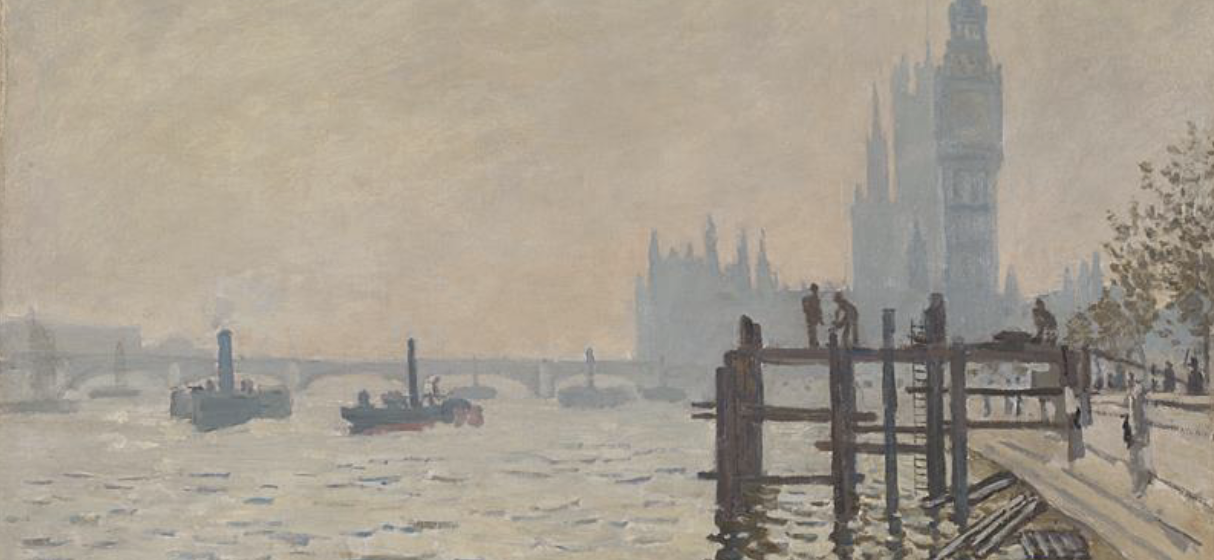
The Thames below Westminster, Claude Monet 1871
developed atmospheric landscape under the influence of Constable, Turner and Whistler during his stay in London
enriched his themes to paint atmospheric elements which affect the perception of the human eye

Nocturne in Blue and Gold, James McNeill Whistler
American painter active in Paris and London
compared painting to music
harmonies arrangement of shapes and colours
atmospheric effect achieved through abstraction of form and colour
composition influenced by Japanese woodcut prints

Impression: Sunrise, Claude Monet 1872
a harbour in Le Havre seen through the morning mists
inspired by Turner’s indistinct images of water landscapes - muddy colour in the background, clam and tranquil unlike Turner’s violent Romantic landscapes
heavily criticised as “worse than a wallpaper design in the embryonic stage”
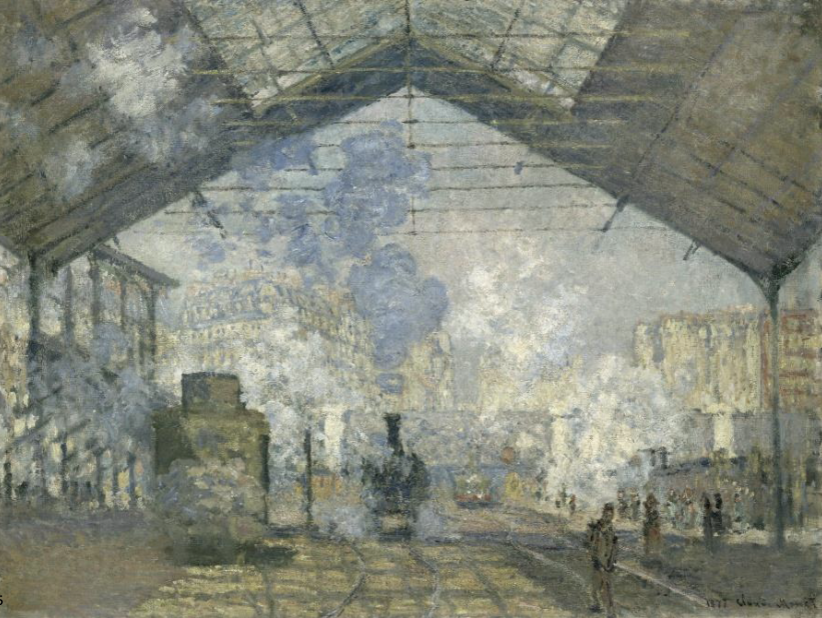
Gare Saint-Lazare (the Auteuil line), Claude Monet 1877
a study of the atmospheric effect of vapour produced by the steam under the glass roof of the railway station
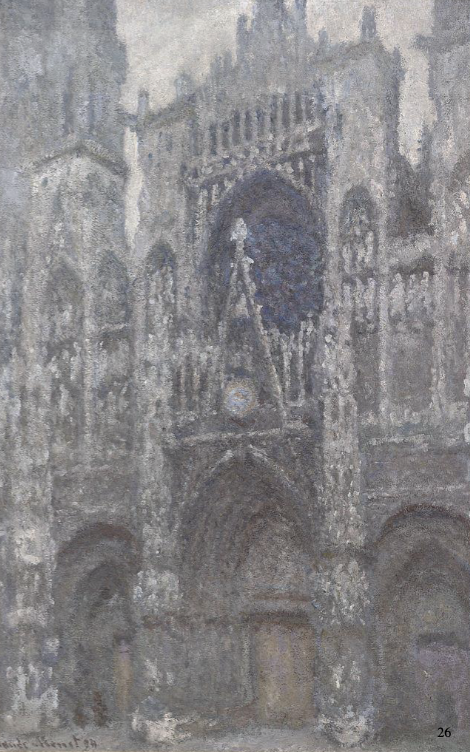
Rouen Cathedral, the Portal and St. Romain Tower in bad weather (Harmony in Grey), Claude Monet 1892
a more challenging subject than the earlier series - fretting of the sculpted surface produces more profound effects of shadow, especially in the recesses of the painted arched portal
heavy, thick paint was applied wet-on-wet to build up the coarse texture of the surface

Rouen Cathedral, the Portal and St. Romain Tower in strong sunlight (Harmony in Blue and Gold), Claude Monet 1893
the texture created imitates and exaggerates the light changes on the surface
within three years Monet produces around 30 views of the same facade during different times of day and seasons of the year
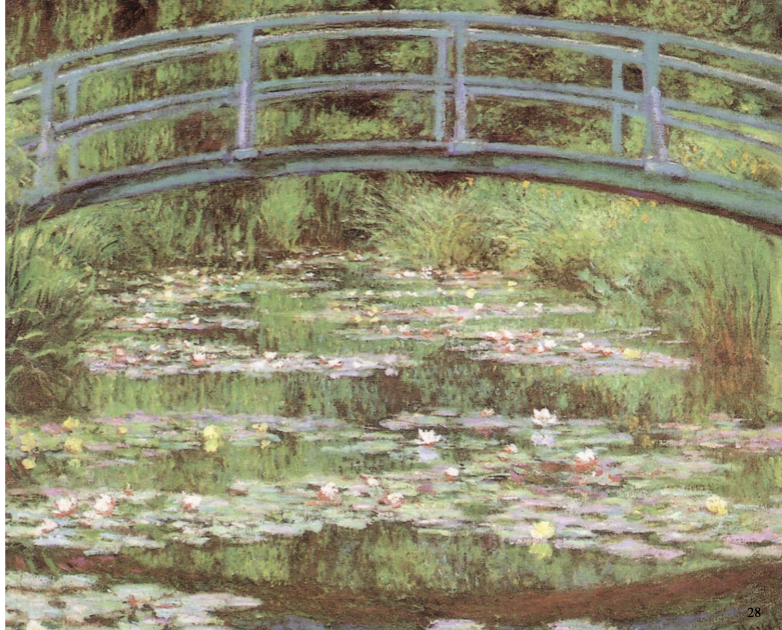
Japanese Footbridge, Claude Monet 1899
worked almost exclusively on the pond and water lilies between 1897 and 1926, produced 250 pieces of this theme
series of paintings with simplified subjects for exclusive, detailed study of light effect
the Japanese bridge is a recurrent motif in the last phase on Monet’s art
Japanisme: influenced by Ukiyo-e woodcut prints
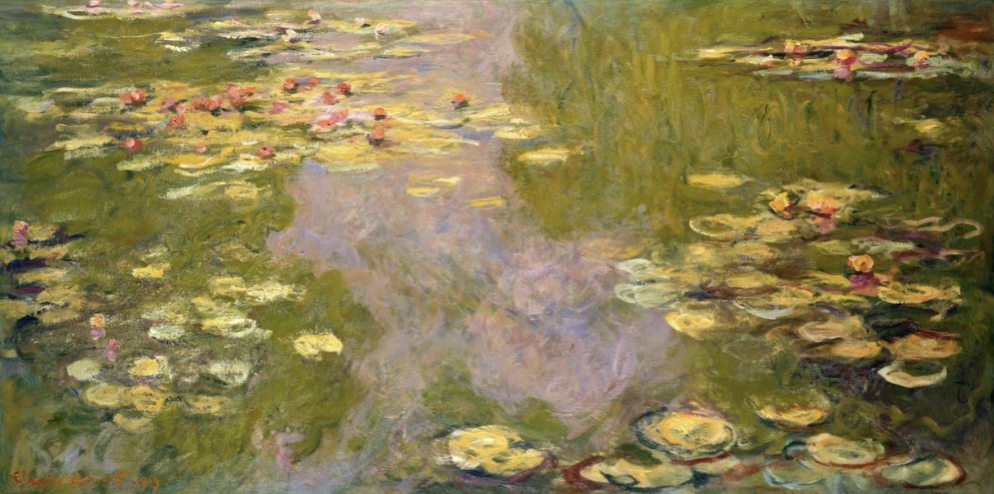
Water Lilies, Claude Monet 1919
spatial ambiguity - absence of any reference to physical reality from 1900
complete abstraction of colour
Pierre-Auguste Renoir (1841-1919)
born in Limoges
1845 - moved to Paris
1854 - worked as a porcelain painter and then a textile painter
1862 - entered Marc Gabriel Gleyre’s studio
end of 1860s - used thick paint, bright colour and painted en plein air with other Impressionists
1870s - imitated Delacroix’s themes of Oriental women
early 1880s - travelled to Italy, Africa and other places
renowned as a painter of beautiful women and lovely children, joyful situations, dancing parties - pay homage to Rococo painters

The Loge (The Theatre Box), Auguste Renoir 1874
theme of contemporary Parisian life
a well-dressed couple in their opera box - Nine Lopez and painter’s brother as models
signature feathery brushstrokes - create a texture with pillowy softness that invites the spectator
Echoes Peter Paul Rubens and his double portrait of himself with his wife - loses and thick brushstrokes anticipate Impressionism
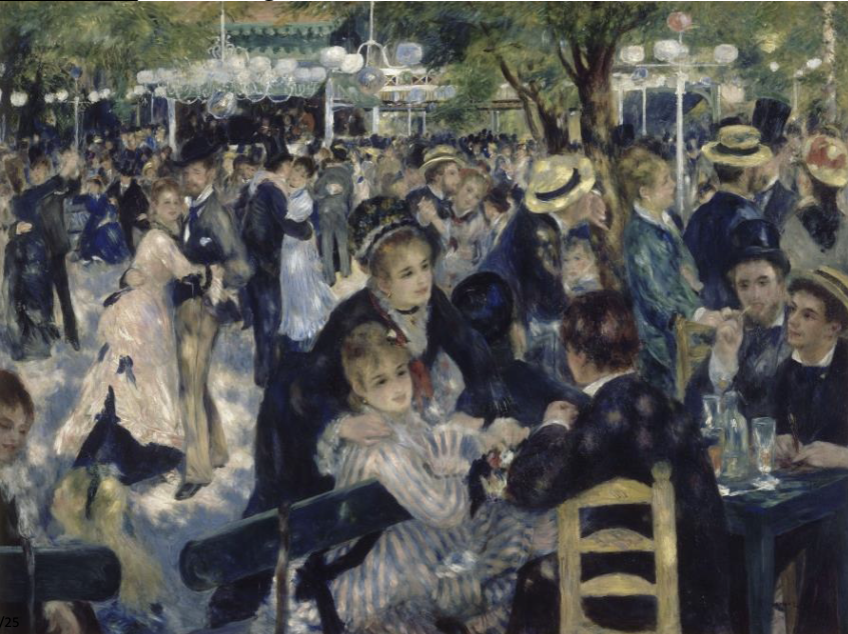
Ball at the Moulin de la Galette, Auguste Renoir 1876
scene of a Sunday dance of the working class in an outdoor dancing hall in Montmartre
captured the pulse of contemporary life
sunlight penetrates through the foliage of the trees
gas lamps
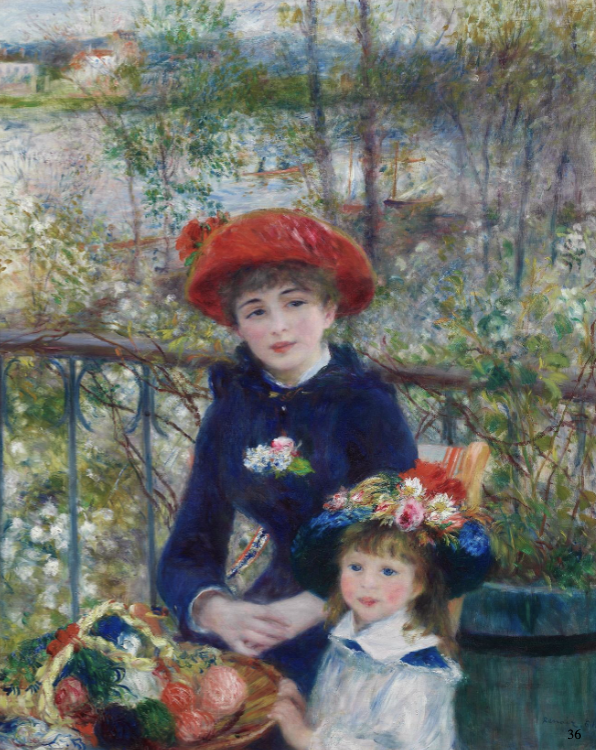
Two Sisters (On the Terrace), Auguste Renoir 1881
Renoir was extremely successful in portraiture
foreground - intensive and saturated colours
background - duller colours and blurry forms ro represent objects seen in humid air
pure colours used by Renoir - lead white, vermilion, cobalt blue, Naples yellow and crimson
white is added wet-on-wet on top of them
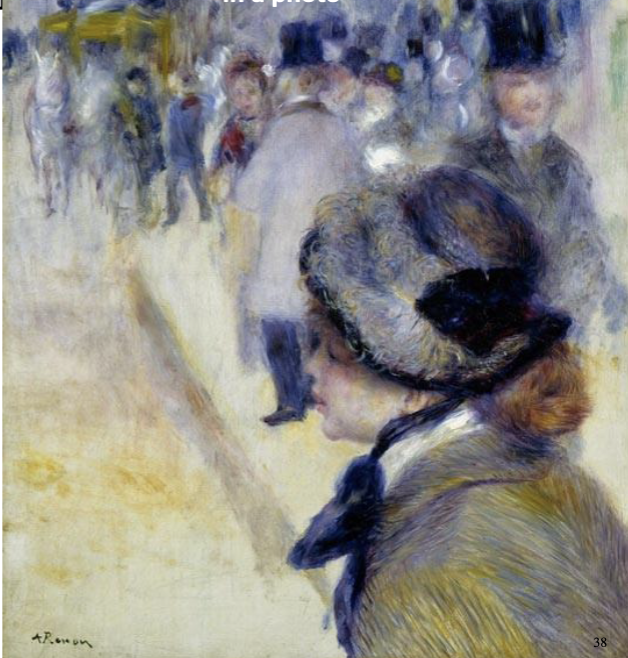
Place Clichy, Auguste Renoir 1880
background out of focus like in a photo
many impressionists interested in photography
composition imitates the snapshot of a busy corner of Paris
spontaneity of a woman entering from the right

Study Sketch for the Bathers 1887 (left) Study, Tirso of a Woman in the Sunlight 1876 (right) Auguste Renoir
return to academic method and style: preparatory sketches for The Bathers - artificial posture, fine details, precise form with sharp contours, smooth and polished painted surface
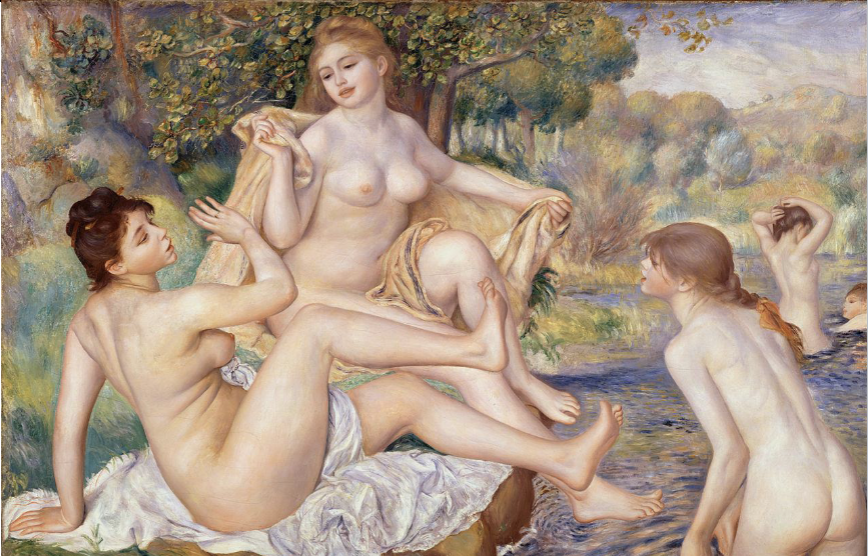
Bathers, Auguste Renoir 1887
trip to Italy in1881-82 caused Renoir to doubt the Impressionist method and belief, began thinking about the notion of eternity in classical art, such as Ingers and Raphael, pursuit of purity and grandeur replaced improvisation
painted totally in studio - reduction of effects of shades on the bodies
classical pyramidal composition

Young Girls at the Piano, Auguste Renoir 1892
burgeois leisure life in a cozy interior reminiscent of Rococo
recalls Jan Vermeer’s genre interiors
soft but orderly brushwork
careful balanced composition
Edgar Degas (1834-1917)
born in a rich banker family
1855 - learnt from Jean-August-Dominique Ingres, then entered the French Academy, wanted to be a history painter
1862 - met Manet and became good friends because of similar background and taste, attracted to Japanese Ukiyo-e paintings
participated in all 8 Impressionist exhibitions but he never mingled with the impressionists, nor created finished works outdoors
experimented with different media, sometimes mixed - oil, pastels or chalks on paper, sculpture and photography
renowned for genre themes of modern life - race track scenes, cafes, ballerinas, working women, women at their toilet
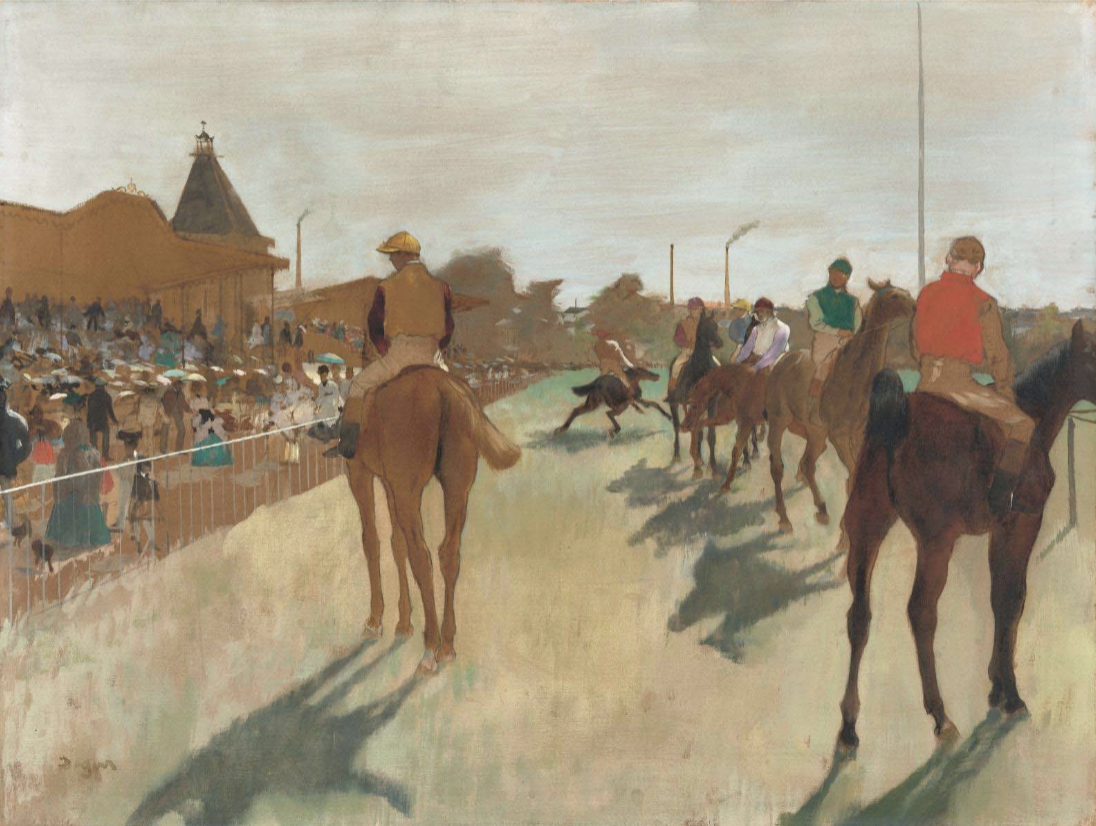
Racehorses in Front of the Grandstand, Edgar Degas 1866-68
favourite leisure activity of Parisian high society
influence of Japanese woodcut prints - forms defined by black contours, flat colour patches, asymmetrical composition
influence of photography - analysis of the movement of horses, photography was used to generate sequences of stop-motion images which proved that a galloping horse lifts all four hooves off the ground

Dance Class, Edgar Degas 1873-76
Degas went backstage to observe rehearsals, captured the casual mood of a group of mice listening to Jules Perrot, a star choreographer
limited range of colour mixed with small patches of primary colours in pastel and intense greens; thin translucent white for the tutus
girl scratching her back
a curious little dog observing
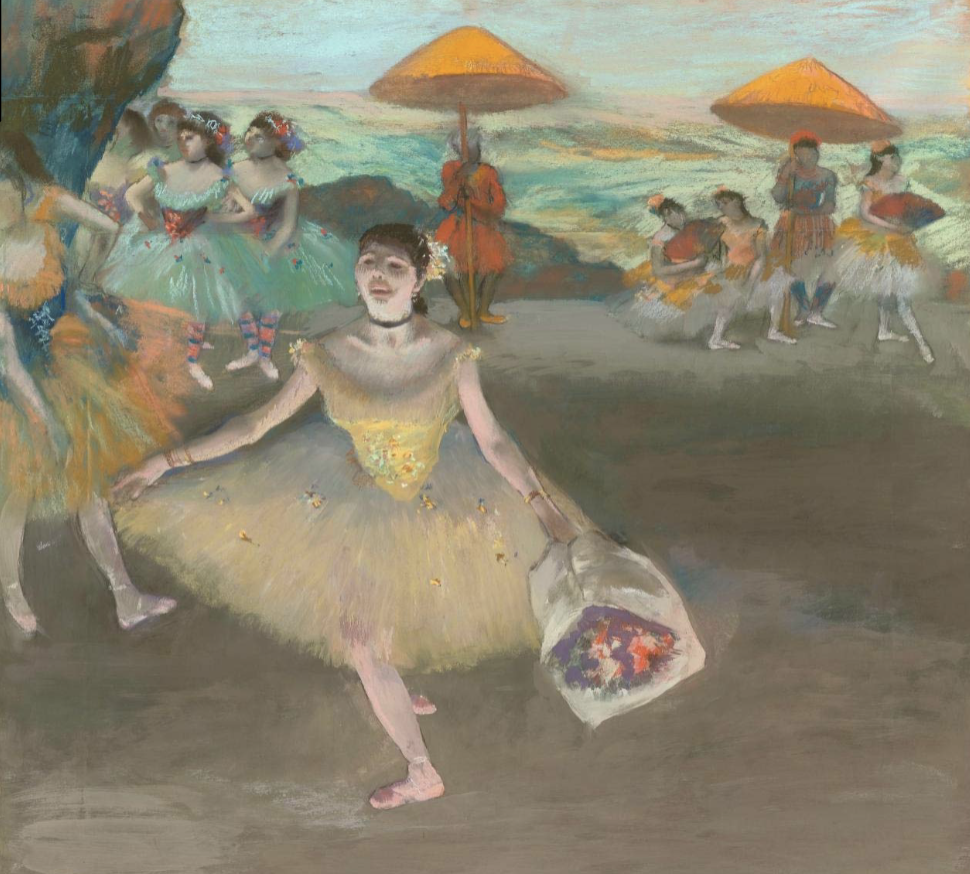
Dancer with a Bouquet, Saluting on the Stage, Edgar Degas 1874
research on the effects of different age lighting angles on colour
yellow-orange tones for the bright light cast from above and below - use of complementary colours
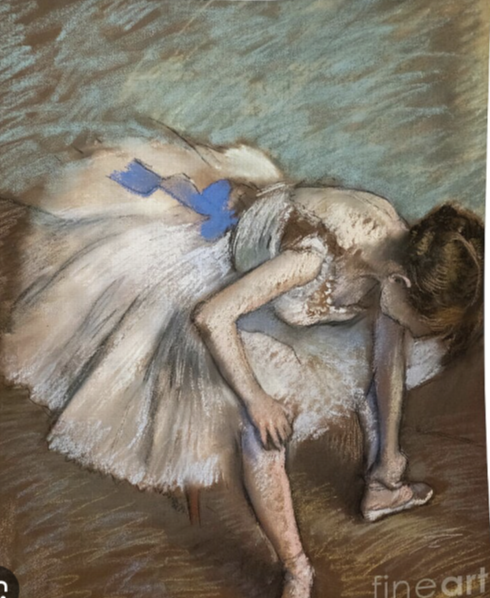
Seated Dancer, Edgar Degas 1881-83
Deans mixed chalk and pastels with oils and other paints
softness of the flesh and the airy quality of the tutu - reminiscent of the texture of Renoir’s beautiful women
Submitted pastels as finished works to exhibitions
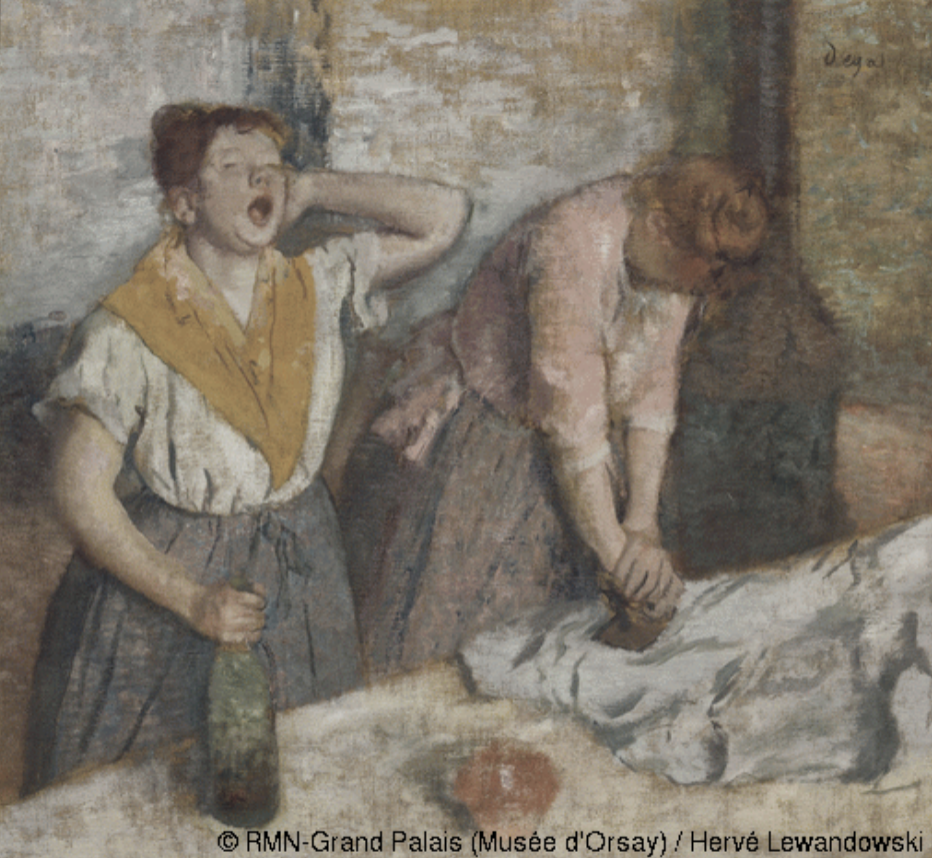
Ironers, Edgar Degas 1884-86
depicts the poor at work
catches their fleeting, everyday movements
neither rhetoric nor caricatured - unlike Daumier
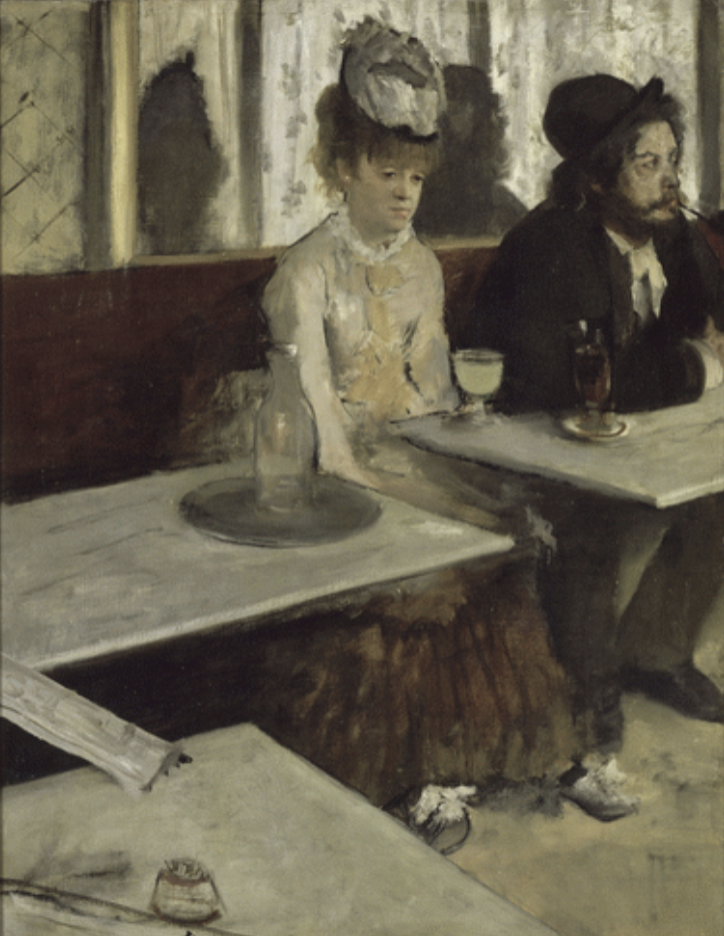
In a Cafe or Absinthe, Edgar Degas 1975-76
cafe as a meeting place for Bohemian intellectuals
Ellen Andre and Marcellin Desboutin posed for the painting
absence of communication, alienation of the modern man
Japonisme
denoted the fascination of Europeans with Japanese art and culture
1853 - Japan opened up to the West
1867 - Japan participated in the Exposition Universelle in Paris
exoticism and alternative standards of beauty appealed to fashionable Parisian society
Ukiyo-e prints themes included contemporary daily life, theatre performances, lower-class people, famous courtesans, landscapes, legends and myths, erotic and provocative scenes → scenes of the “floating world”, reinforces impressionist idea of capturing the fleeting moment of the world
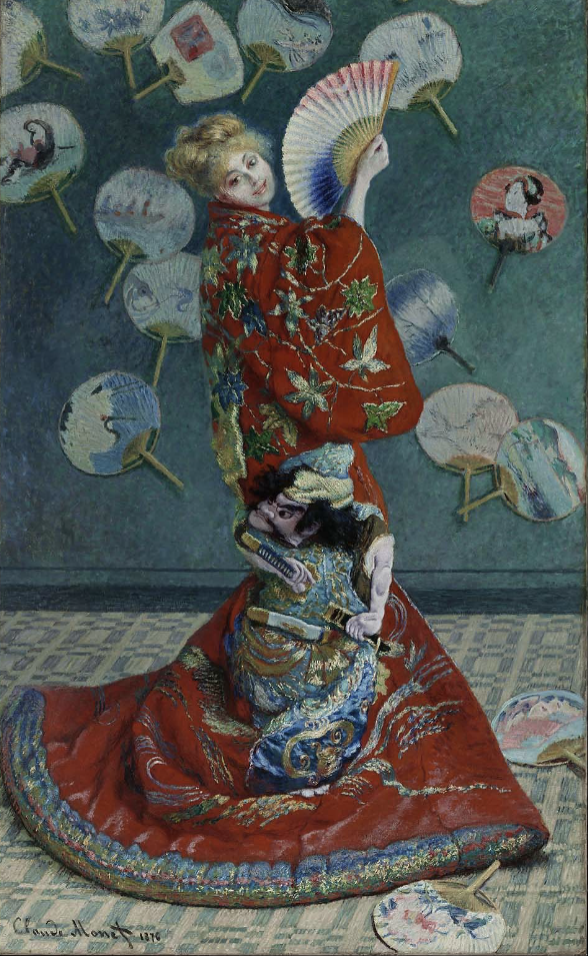
La Japonaise, Claude Monet 1876
more than just the display of Japanese props in composition
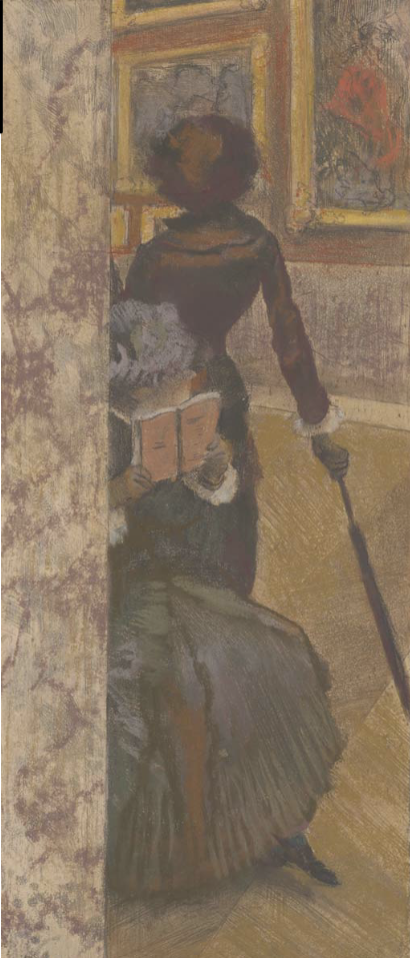
Mary Cassatt in Louvre, Edgar Degas 1885
Japanese influence - unusually long format, high angle of presentation nd truncated figures
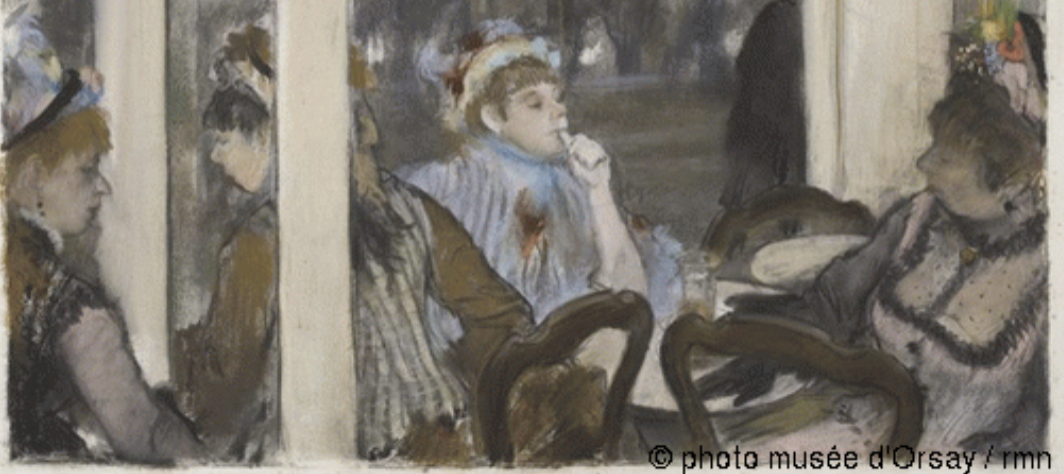
Women on the Terrace of a Cafe in the Evening, Edgar Degas 1877
architectural element cuts figure into halves
prostitutes waiting for customers
an interior opening to the outside
inspired by Geishas enjoying a leisure moment in a meeting that opens to the exterior, also figure cut in half
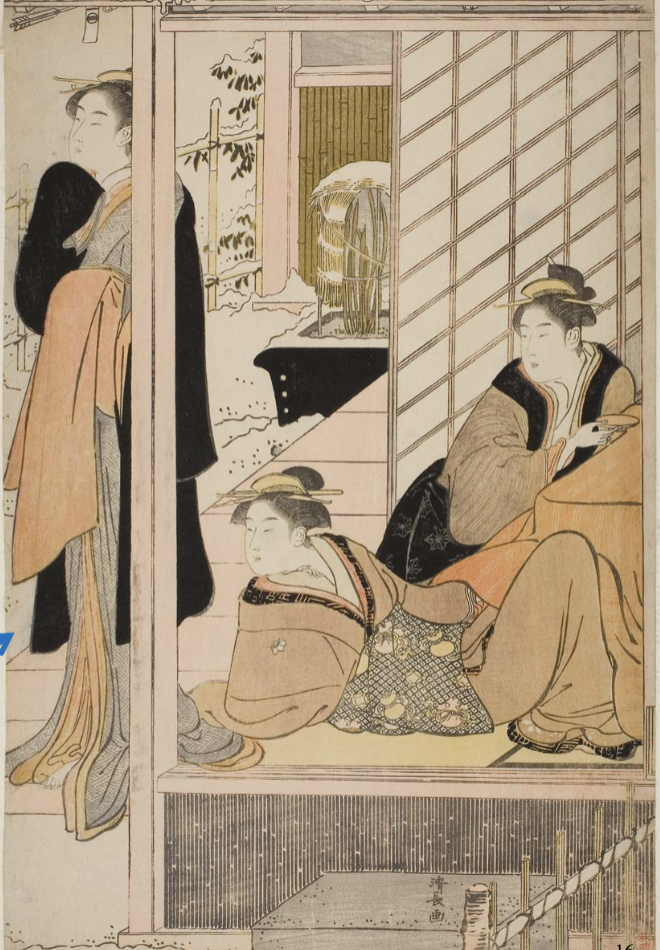
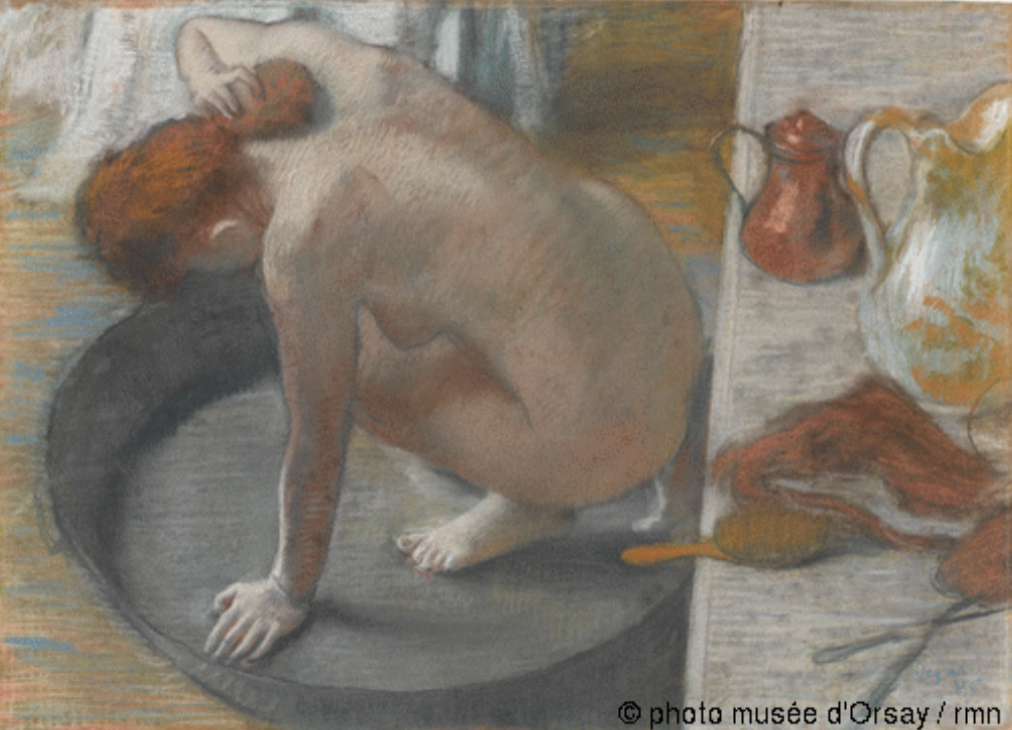
The Tub, Edgar Degas 1886
high angle presenting figure and objects
table on the right → no foreshortening treated as 2D surface
combination of European classical and Japanese cultures by Degas
He collected Japanese prints and owned one which inspired him to create various works of women at their toilet
Camille Pissarro (1830-1903)
settled in Paris in 1855
Learned landscape painting with Gustave Courbet and Camille Corot
Alfred Sisley (1839-1899)
Brit born in Paris
Student of Marc Gabriel Gleyre, friends with Monet and Renoir
Influenced by Constable and Turner, but attracted to the bright colour and sunny landscapes of Corot

Self-Portrait, Camille Pissarro 1873
figure - lifted through alternative use of 2 basic colours, cream and brown
careful study of the reflection of light off of different parts of the surfaces
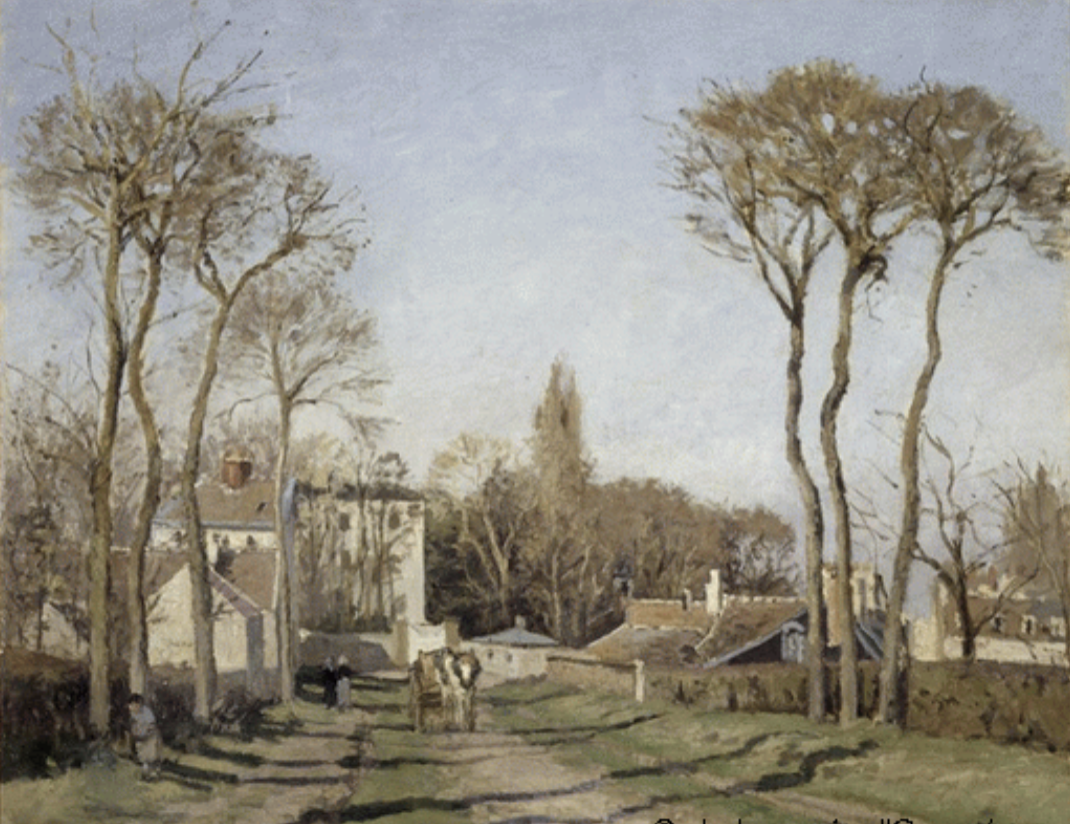
Entrance to the Village of Visions, Camille Pissarro 1872
favourite motifs: village road flanked by trees running into the depth
light colour and shadows - bright sunshine
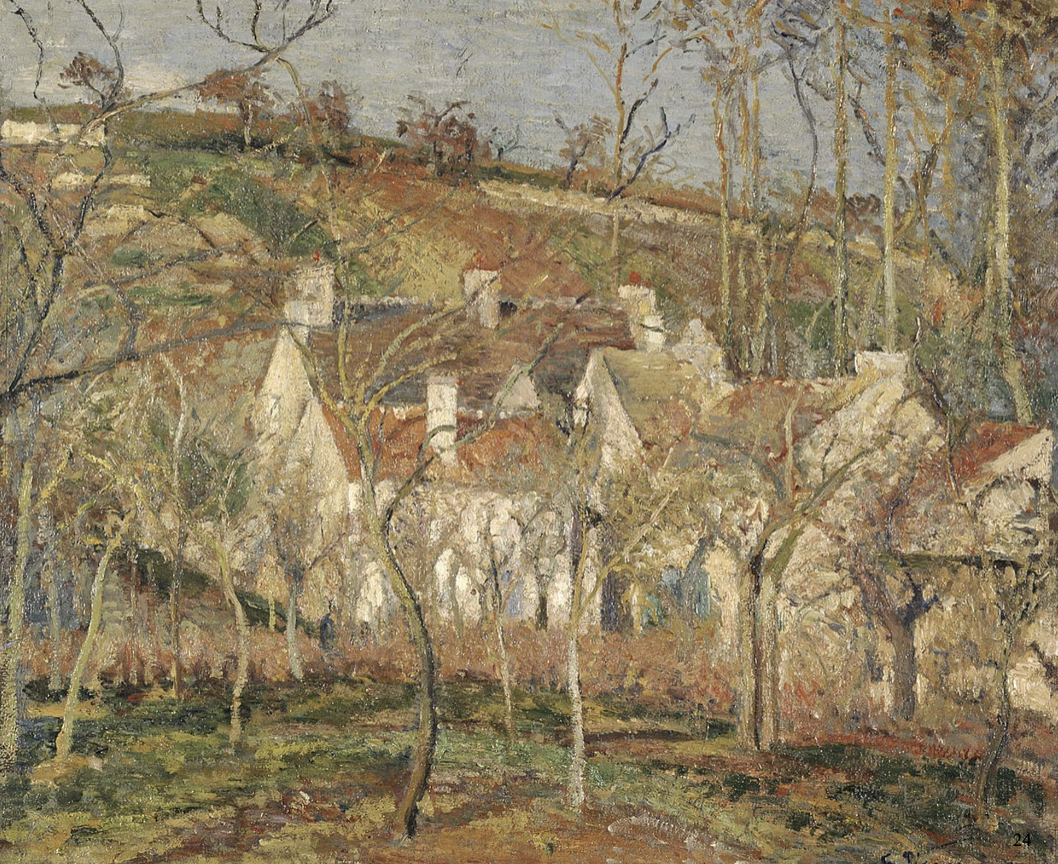
Red Roofs, Corner of a Village, Winter Effect, Camille Pissarro 1877
put the emphasis on the geometric structure of landscapes - exerted influence on Paul Cezanne
used thick impasto of light tones to catch light
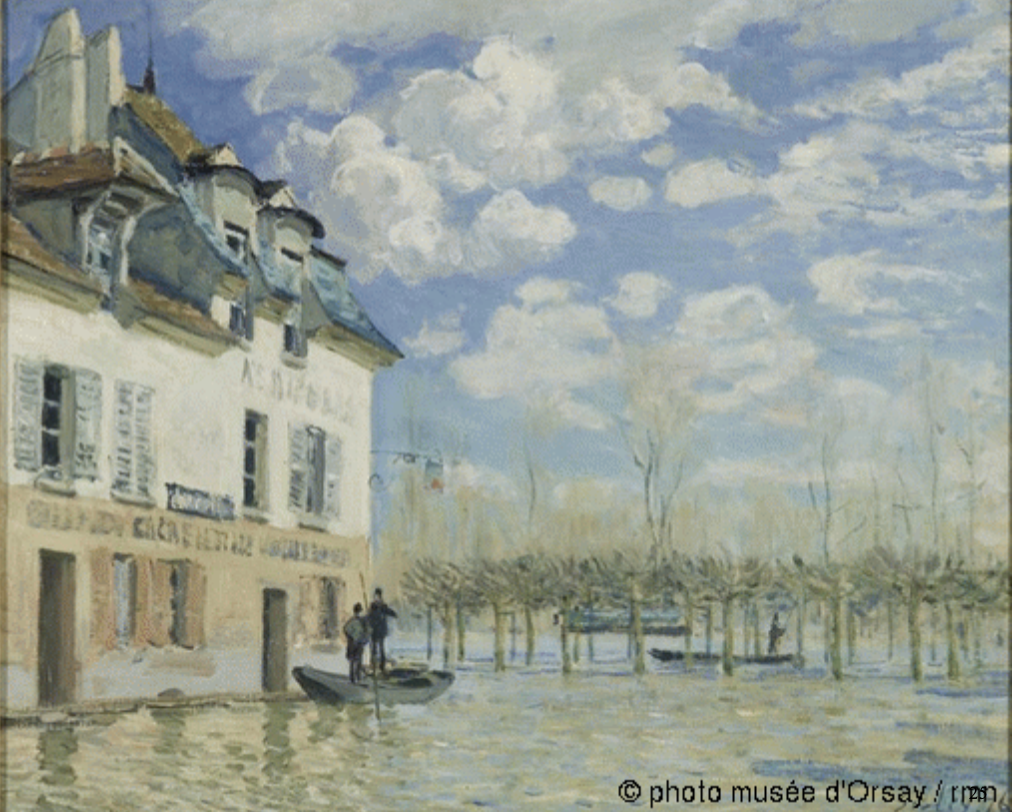
Boat in the Flood at Port Marly, Alfred Sisley 1876
impressionistic water landscape combined with a sky typical of 17th century Dutch painting
The flood of Seine in 1876 gave the painter a good chance to study the reflection of house trees and people on the water surface

Paris Street; Paint Day, Gustave Caillebotte 1877
representation of the result of the Haussmann Renovation
gas street lights installed in Paris since 1828
alienation of city dwellers
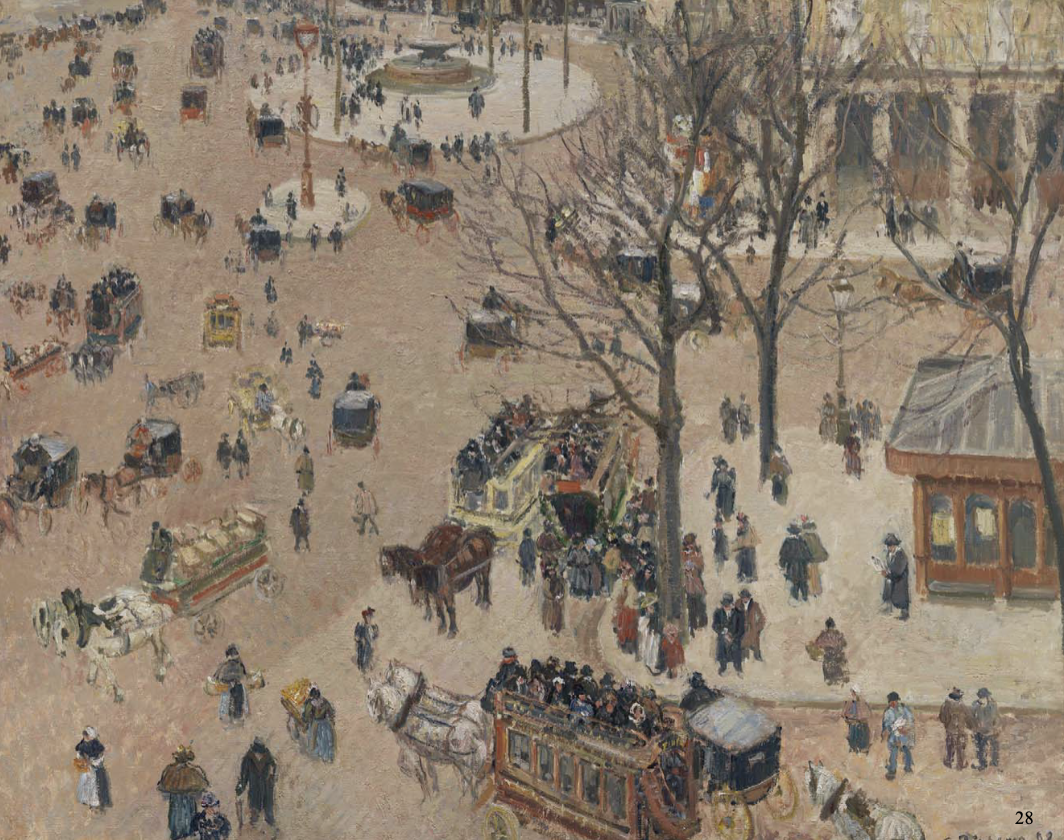
La Place du Theatre Francais, Camille Pissarro 1898
crowded Paris square seen from several stories above the street level
Pissarro used photography to capture scenes he wanted to paint
Spatial flatness because of high viewpoint and the arbitrary cutting off of figures at the edges echo photography
Women Painters
still not socially acceptable for women to paint outdoors
typical works - intimate, indoor scenes, family and leisure activities
outdoor scenes - studio compositions with model of created in semi-open private premises
Berthe Morisot (1841-1895)
first woman Impressionist
Student of Camille Corot, sister in law of Edouard Manet
made close friendship and exhibited with the Impressionists
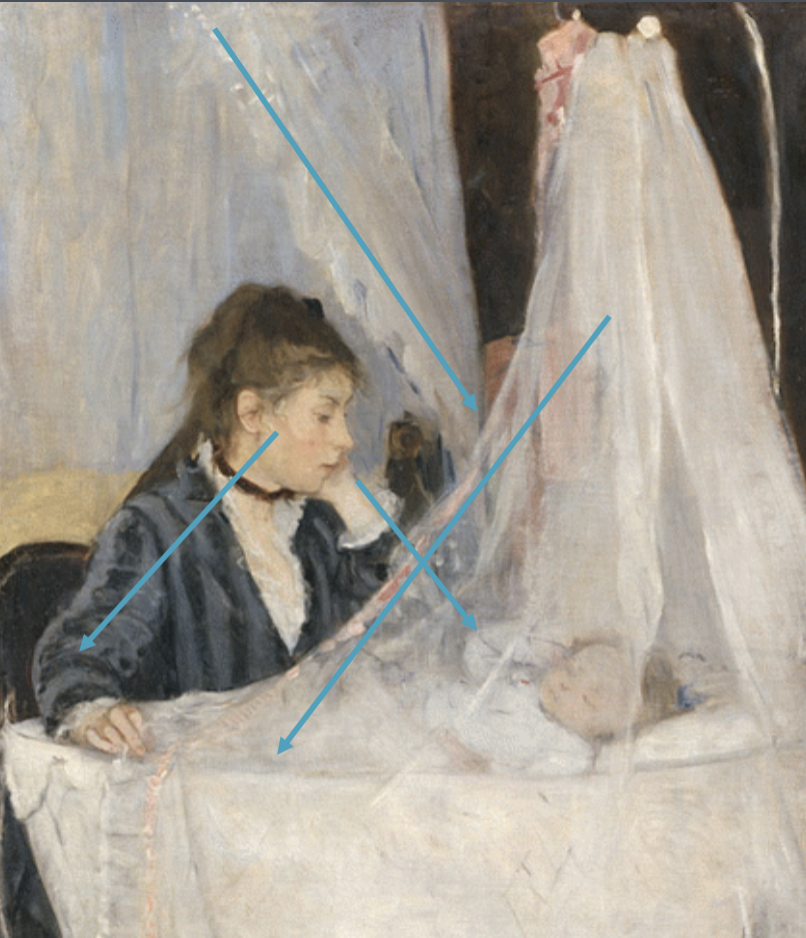
Cardle, Berthe Morisot 1872
themes: family life of well to do women and children
translucent paint, feathery brushstrokes - softness and warmth
distinct zones of black and white tones - influence from Manet’s Olympia

In a Villa at the Seaside, Berthe Morisot 1874
vacation of her upper class family in Normandy
foreground - short quick suggestive brushstrokes
background - almost homogeneous treatment of sky and sea
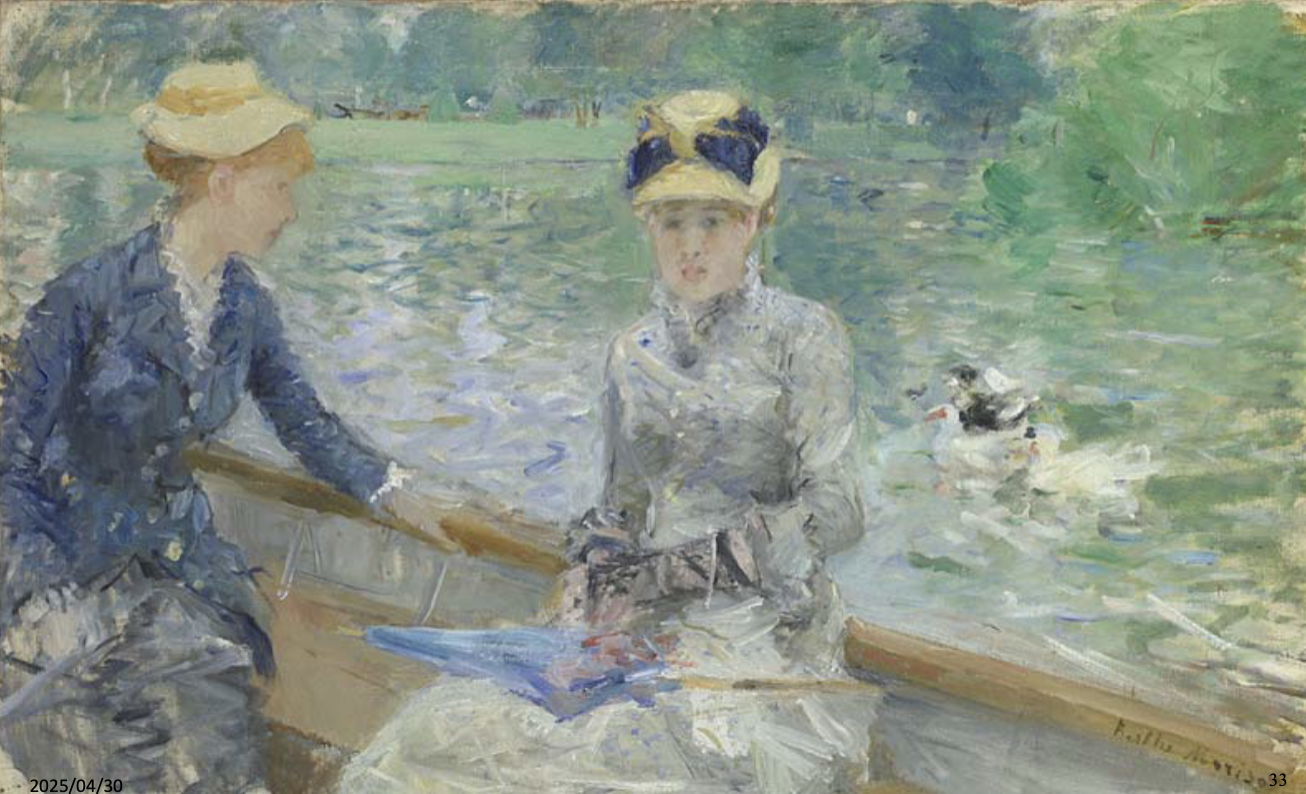
Summer’s day, Berthe Morisot 1879
undefined contours, quick, coarse and zig-zag brushstrokes → energise Monet’s and Renoir’s calm water surface
Mary Cassatt (1844-1926)
born in Pittsburgh of a wealthy family
studied at the Pennsylvania Academy of the Fine Arts
1866 - moved to France and befriended Degas
only American to exhibit with the Impressionists
dealer of Impressionist paintings for wealthy American collectors
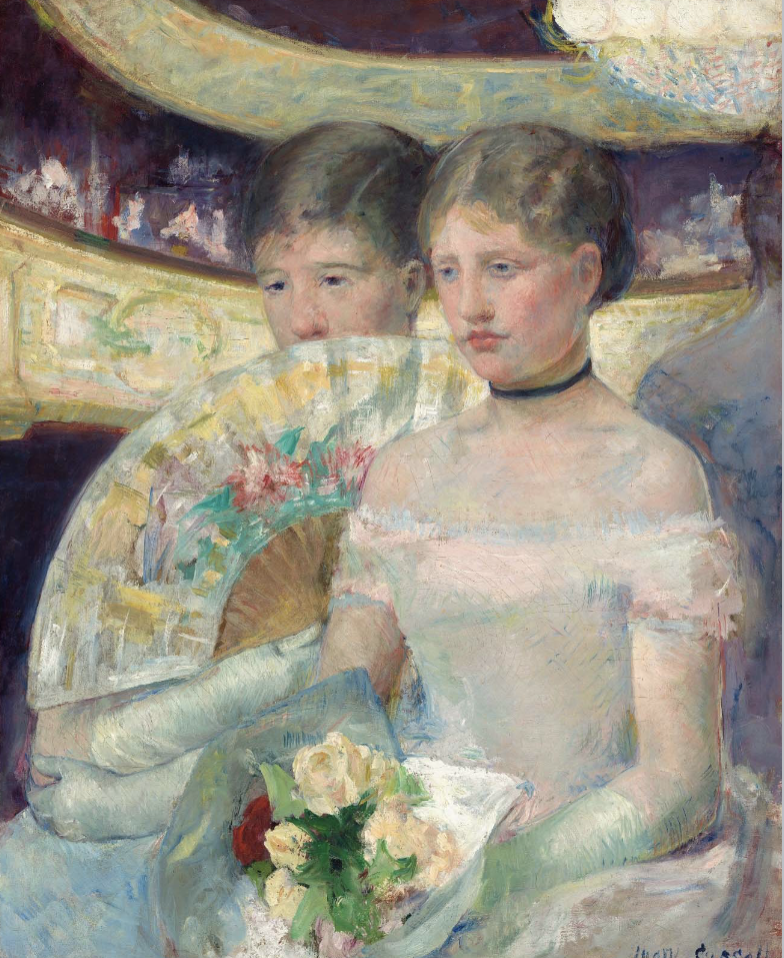
The Loge, Mary Cassatt 1878-80
Impressionistic interest in light and reflection extended to interior settings
dazzling glamour of the theatre speaks of modernity and luxury of Parisian high society

The Child’s Bath, Mary Cassatt 1893
influence of Japanese woodblock prints : high vantage point, female subject
favourite theme: women caring for children, created also in pastels, learned from Degas
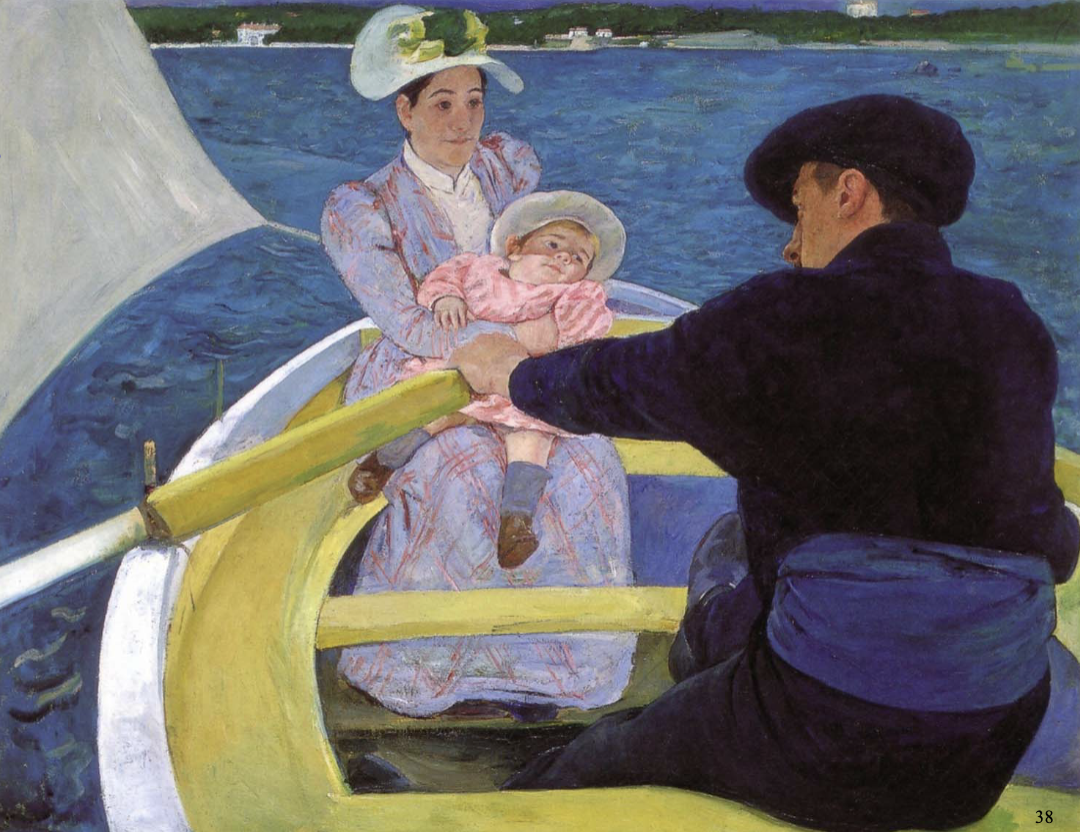
The Boating Party, Mary Cassatt 1893-94
hard contours, flat surfaces, simplified colour blocks - resemble Ukiyo-e prints
bold geometry and decorative patterning - connect her with post-impressionists